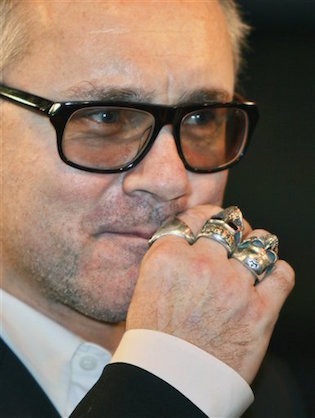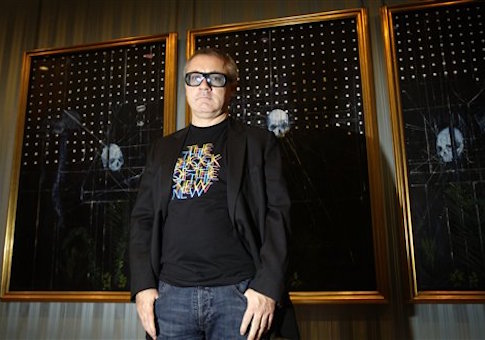Damien Hirst’s wares are exhibited in one room of the National Gallery, a cramped elevator lobby on the bottom floor that leads directly into a gift shop. For anyone else, the placement could be mistaken for an insult; for Hirst, the metaphor fits. Hirst came from humble and troubled beginnings—from the bottom floor of society, so to speak. Early in life he fell in with a bad crowd and had several run-ins with the law, but soon after discovered his talent for showmanship and salesmanship. His professional ascent was meteoric, easily outstripping the young Brits who competed against him for attention in the 1990s. Now the begoggled businessman sits commandingly in the industry C-suite. He has his critics, yes, but with a bundle of awards and a net worth of approximately $300 million, he can safely tell them to soak their heads in formaldehyde. Truly, Damien Hirst has made it.
The 13 prints from Hirst’s 1999 product line "The Last Supper" mimic the labels on pill bottles, but with the names of medicines swapped out for common foods. "DUMPLING, 10 mg, 28 tablets" reads a label in Pepto-Bismol pink. "Meatballs / Gravy. Use only as directed by a physician. KEEP OUT OF REACH OF CHILDREN" commands a sienna- and sand-colored label. "Beans™, Chips™—112 chips" states a red-brown label stamped with a company emblem in one-foot-tall block letters: DAMIEN & HIRST.

Like all of Hirst’s products, the pill labels are littered with references to the creator (lower-case c, whatever the exhibition’s title). Damien-Hirst Ltd. HirstDamien. Simply "DAMIEN." This in-your-face branding could be viewed as the flourishes of an egotist—of a powerful man who couldn’t stamp his face on money but could affix his name to the things money can buy. But that would only tell part of the story. The branding is also there to reassure customers, like Heather and Tony Podesta, the wealthy lobbyists and kindred spirits of Hirst who donated the prints to the NGA. The Hirst brand is a sign of status and quality, at least of a sort: In a sea of generics—blank canvasses, anarchic brushwork, everyday items transmogrified by theory into high culture—the name is the thing that stands out, that sells at auctions, that impresses guests at house parties. Without it, Hirst’s works might be mistaken for their worthless competitors; and if they could be mistaken for their worthless competitors, what then would be the point of owning them?
That is why, one guesses, Hirst goes to such lengths to make his products recognizable, even when he cannot sign his name on them in one-foot-tall block letters. While there is some variety in his work, he has struck on a few iconic concepts and reproduced them many times with minor variations. If one is to generalize, his work can be reduced to two categories: Dots and dead things.
Hirst began working with dots (or "spots," as they are technically and un-alliteratively named) in the mid-1980s. Hirst’s spots are multi-colored, uniform in size and spacing, and overlaid on white backgrounds. Some of the iterations have large spots, some have small spots. Some are on square canvasses, some on circular canvasses. At least one is painted onto a Mini Cooper worth approximately 700 grand. Famously, Hirst made the first half-dozen or so canvasses and then handed the task off to his assistants, who churned out the next thousand. Now he is testing the outer limits of the concept—going where no man has gone before—by creating a canvas with one million tiny dots. The project will take his assistants nine years to complete.
A broader swathe of Hirst’s output concerns dead things. His most iconic work, "The Physical Impossibility of Death in the Mind of Someone Living," consists of a dead tiger shark pickled in eerie, sea-green formaldehyde. His second most iconic work, "For the Love of God," is a platinum cast of a human skull bedazzled with 8,601 flawless diamonds—a memento mori that misses the point in spectacular fashion. His third most iconic work, "A Thousand Years," is a cow’s head with a humming, crackling "insect-o-cutor" hanging overhead to smite flies feeding on the cow’s putrefying flesh. Following in the trail of these three works are a clutter of other, very similar works, including an infant skull covered in pink diamonds and dozens of pickled animals in unrestful repose, propped up on toilets or nailed to crucifixes to lend variety to the scenes.
Hirst is a babbling, unimpressive presence in interviews, but his works are packaged with mystical, impressive-sounding titles and placards outlining the big questions his works are intended to raise. So, for instance, the thirteen prints of "The Last Supper" represent the twelve disciples and Jesus Christ. The exhibition provokes viewers to consider, according to the placard beside the elevator, "whether faith in medicine, with its promise to stave off disease and death, is now comparable to faith in religion." This is a serious and elevated question for an overprescribed and irreligious culture to ask, but the dissonance between its seriousness and the amateurishness of the actual work is hard to escape. The thirteen prints of "The Last Supper" are utterly pedestrian from a design standpoint—the sort of thing one would blow right past if they hung in a regional airport or Quiznos. And then there is the concept itself. How, exactly, does a pill label with the word "Sandwich" on it help us think about drug abuse, except insofar as it sheds light on a certain hazy decade in Hirst’s own life?
Further dissonance exists between the work and the bad boy image Hirst has cultivated through his juvenile antics and heavy skull jewelry and brooding photographs. "The Last Supper" is as un-rebellious as it is unhelpful as an aid to deep thinking. None of Hirst’s work qualifies as rebellious in the sense of upsetting or even tweaking the powers that be in his world. Sir Nicholas Serota, director of the Tate, practically sings Hirst’s hosannas; his work is welcome in any contemporary museum and at the Olympics, for that matter, where it is greeted by large gawking crowds and snapped up by status-hungry tycoons. Hirst, in other words, has pulled off a coup: Drawing from the tradition of James Dean and Fonzie, he has marketed safe rebellion.
So Hirst’s critics—all the defenders of the long and magnificent history of art—can storm, and storm they will: When Hirst put on airs by holding an exhibition of traditional oil paintings at the Wallace Collection in 2009, the buttoned-up, decorous Brian Sewell deemed it "fucking dreadful." It won’t matter one whit to Hirst, who can make six figures off the spotty labor of an intern. At the end of the day, Damien Hirst gets to ask all the big questions he wants. Next up: Can he crack $500 million?
